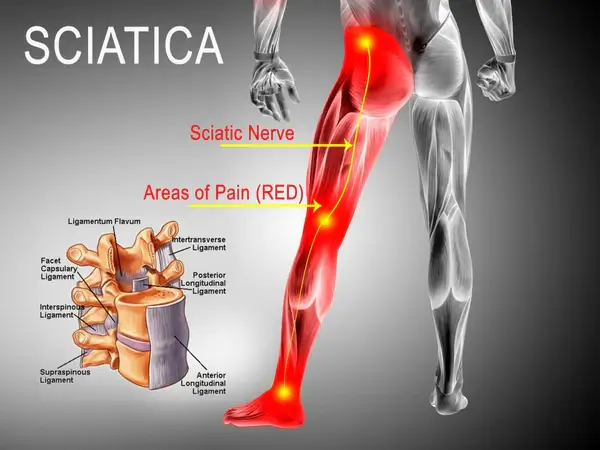Endometriosis is a medical condition that affects millions of people worldwide. It occurs when tissue similar to the lining of the uterus grows outside of the uterus, causing pain, infertility, and other symptoms.
CUPERTINO, CALIFORNIA | NOW THEN DIGITAL — Endometriosis is a medical condition in which the endometrial tissue, similar to that which lines the uterus, grows outside of it. It can cause pain, irregular periods, and infertility.
In some cases, this tissue can put pressure on the sciatic nerve, leading to a condition called sciatic endometriosis.
In this article, we will discuss the symptoms, diagnosis, and treatment options for sciatic endometriosis.

How Endometriosis Affects the Sciatic Nerve
Endometrial implants usually grow in and adhere to organs in the pelvis, such as the ovaries, fallopian tubes, bladder, intestines, rectum, or peritoneum. In some rare cases, the endometrial tissue grows in the area of the pelvis just above the sciatic nerve.
This is the longest nerve in the body, running from the lower back down the back of each leg. When endometrial lesions put pressure on the sciatic nerve, it can cause irritation and inflammation. Higher-than-normal levels of estrogen are often the cause of this abnormal growth.
Symptoms
Leg pain and weakness are the most common symptoms of sciatic endometriosis. These symptoms often occur around the time of the menstrual cycle.
People with sciatic endometriosis may also experience painful, heavy, and irregular periods, pain during sex, urination, and bowel movements, and pain in the pelvis, stomach, lower back, hips, and buttocks.
Other symptoms include weakness, numbness, tingling, burning, or a dull aching sensation in the back of one or both legs, difficulty walking or standing, limping, lack of balance, infertility, bleeding between periods, constipation or diarrhea just before or after the period, fatigue, and foot drop (trouble lifting the front of the foot).
If you’re experiencing irregular periods, spotting, or pain around the time of your menstrual cycle, it’s essential to speak to your healthcare provider. Sciatic endometriosis can cause nerve damage over time, making it even more critical to seek treatment as soon as possible.
Diagnosis and Treatment of Sciatic Endometriosis
Sciatic endometriosis is relatively rare, and it can’t be diagnosed with a pelvic examination or ultrasound alone.
A biopsy using laparoscopy may be necessary to determine the presence of endometrial implants. Imaging tests such as magnetic resonance imaging and computed tomography scans can also provide information about the location and size of endometrial implants.
Treatment options for sciatic endometriosis include over-the-counter pain relievers, such as Advil or Motrin, gentle exercise, physical therapy, and applying heat or cold to the affected area. Hormonal treatment may be prescribed to prevent new endometrial implants from growing.
If the pain persists or gets worse, surgery to remove the endometrial tissue may be necessary. In severe cases, a hysterectomy may be recommended.
Taking medication or undergoing physical therapy for pain relief is often the first step in treating sciatic endometriosis. Laparoscopic surgery to remove endometrial implants or a complete hysterectomy may be necessary for severe and/or persistent pain.
Infertility Treatment for Sciatic Endometriosis
For individuals with sciatic endometriosis who wish to get pregnant, fertility treatment such as in vitro fertilization may be helpful.
An infertility evaluation with an ob-gyn is essential if you’ve been having unprotected sex for a year or more without conceiving, or for at least six months if you’re 35 years or older.
For those with sciatic endometriosis who wish to conceive, fertility treatment such as in vitro fertilization may be an option. If you’ve been trying to conceive without success, reach out to an ob-gyn for an infertility evaluation. They can help determine if fertility treatment is right for you.
Talk to Your Healthcare Provider

If you’re experiencing any of these symptoms, it’s important to talk to your healthcare provider. They can help diagnose the condition and develop a treatment plan tailored to your needs.
In some cases, sciatic endometriosis can cause nerve damage if left untreated, so it’s important to seek care as soon as possible.
Conclusion
Sciatic endometriosis is a rare condition that causes leg pain and weakness. It is caused by the growth of endometrial tissue around the sciatic nerve. If you experience any of the symptoms mentioned above, it’s essential to consult your healthcare provider.
They can help diagnose and treat your condition, providing relief from pain and discomfort.
Editor’s Note: We would appreciate it if you could reach out to press@nowthendigital.com if you find any outdated or inaccurate content.













